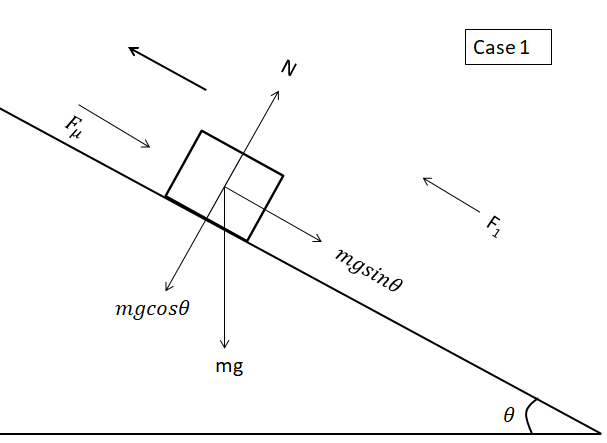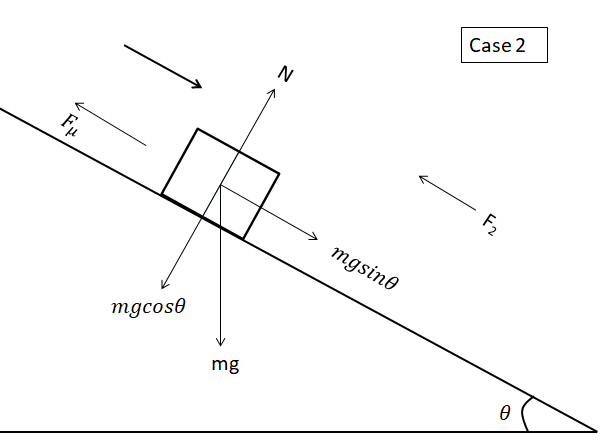Answer
402.3k+ views
Hint: Making the free body diagram will help you to understand how the forces are acting on the body in each case. The first case is when the force acts on the body, when the body is just about to move up. In this case, the frictional force acts against the direction of force acting on the body.
The second case is when the force acts on the body to prevent it from slipping. In this case, the frictional force acts along the direction of the force acting on the body.
Then we just need to equate the horizontal force and vertical force for both the equations. On solving those equations, we will get the value of inclination.
Complete step-by-step answer:
Now we make the basic force body diagrams for 2 cases. The explanation of the cases will be discussed below; we first understand the forces involved and how to make the force body diagram.
The inclination is considered $\theta$ and we have the body on the inclined plane. Drawing perpendiculars to it from the center of mass of the body will give us the force due to gravity acting vertically downward. The sine and cosine components of this force and the Normal component of this force are upon the other perpendiculars as per the diagram.
We know that the frictional force${ f }_{ \mu }$ is given by ${ f }_{ \mu }=\mu N$.
$N=mg\cos { \theta }$
Now, let’s understand the 2 cases:


Case 1 corresponds to the force acting on the body, when the body is just about to move up.
Let’s consider the force acting on the body as ${ F }_{ 1 }$.
Similarly, case 2 corresponds to the force acting on the body to prevent it from slipping.
Let’s consider the force acting on the body in this case as ${ F }_{ 2 }$.
From the force body diagrams we have,
${ F }_{ 1 }=mg\sin { \theta } +{ f }_{ \mu }$
${{F}_{1}}=mg\sin \theta +\mu mg\cos \theta \to (1)$
${ F }_{ 2 }=mg\sin { \theta } -{ f }_{ \mu }$
${{F}_{2}}=mg\sin \theta -\mu mg\cos \theta \to (2)$
As per the given condition: ${ 2F }_{ 2 }={ F }_{ 1 }$.
Therefore, from eqn (1) and (2) we get,
$2(mg\sin { \theta } -\mu mg\cos { \theta } )=(mg\sin { \theta } +\mu mg\cos { \theta } )$
$mg\sin { \theta } =3\mu mg\cos { \theta }$
$\tan { \theta } =3\mu$
Therefore the inclination angle $\theta =\tan ^{ -1 }{ 3\mu }$.
Note: When making the force body diagram for these cases, always remember that the frictional force will be against the direction of motion of the body.
Here there are 2 very specific cases of direction of motion of the body, even though we are applying force along the same direction.
The second case is when the force acts on the body to prevent it from slipping. In this case, the frictional force acts along the direction of the force acting on the body.
Then we just need to equate the horizontal force and vertical force for both the equations. On solving those equations, we will get the value of inclination.
Complete step-by-step answer:
Now we make the basic force body diagrams for 2 cases. The explanation of the cases will be discussed below; we first understand the forces involved and how to make the force body diagram.
The inclination is considered $\theta$ and we have the body on the inclined plane. Drawing perpendiculars to it from the center of mass of the body will give us the force due to gravity acting vertically downward. The sine and cosine components of this force and the Normal component of this force are upon the other perpendiculars as per the diagram.
We know that the frictional force${ f }_{ \mu }$ is given by ${ f }_{ \mu }=\mu N$.
$N=mg\cos { \theta }$
Now, let’s understand the 2 cases:


Case 1 corresponds to the force acting on the body, when the body is just about to move up.
Let’s consider the force acting on the body as ${ F }_{ 1 }$.
Similarly, case 2 corresponds to the force acting on the body to prevent it from slipping.
Let’s consider the force acting on the body in this case as ${ F }_{ 2 }$.
From the force body diagrams we have,
${ F }_{ 1 }=mg\sin { \theta } +{ f }_{ \mu }$
${{F}_{1}}=mg\sin \theta +\mu mg\cos \theta \to (1)$
${ F }_{ 2 }=mg\sin { \theta } -{ f }_{ \mu }$
${{F}_{2}}=mg\sin \theta -\mu mg\cos \theta \to (2)$
As per the given condition: ${ 2F }_{ 2 }={ F }_{ 1 }$.
Therefore, from eqn (1) and (2) we get,
$2(mg\sin { \theta } -\mu mg\cos { \theta } )=(mg\sin { \theta } +\mu mg\cos { \theta } )$
$mg\sin { \theta } =3\mu mg\cos { \theta }$
$\tan { \theta } =3\mu$
Therefore the inclination angle $\theta =\tan ^{ -1 }{ 3\mu }$.
Note: When making the force body diagram for these cases, always remember that the frictional force will be against the direction of motion of the body.
Here there are 2 very specific cases of direction of motion of the body, even though we are applying force along the same direction.
Recently Updated Pages
Basicity of sulphurous acid and sulphuric acid are

Assertion The resistivity of a semiconductor increases class 13 physics CBSE

Three beakers labelled as A B and C each containing 25 mL of water were taken A small amount of NaOH anhydrous CuSO4 and NaCl were added to the beakers A B and C respectively It was observed that there was an increase in the temperature of the solutions contained in beakers A and B whereas in case of beaker C the temperature of the solution falls Which one of the following statements isarecorrect i In beakers A and B exothermic process has occurred ii In beakers A and B endothermic process has occurred iii In beaker C exothermic process has occurred iv In beaker C endothermic process has occurred

The branch of science which deals with nature and natural class 10 physics CBSE

What is the stopping potential when the metal with class 12 physics JEE_Main

The momentum of a photon is 2 times 10 16gm cmsec Its class 12 physics JEE_Main

Trending doubts
Difference between Prokaryotic cell and Eukaryotic class 11 biology CBSE

Fill the blanks with the suitable prepositions 1 The class 9 english CBSE

Two charges are placed at a certain distance apart class 12 physics CBSE

Difference Between Plant Cell and Animal Cell

What organs are located on the left side of your body class 11 biology CBSE

Change the following sentences into negative and interrogative class 10 english CBSE

The planet nearest to earth is A Mercury B Venus C class 6 social science CBSE

The Equation xxx + 2 is Satisfied when x is Equal to Class 10 Maths

What is BLO What is the full form of BLO class 8 social science CBSE



